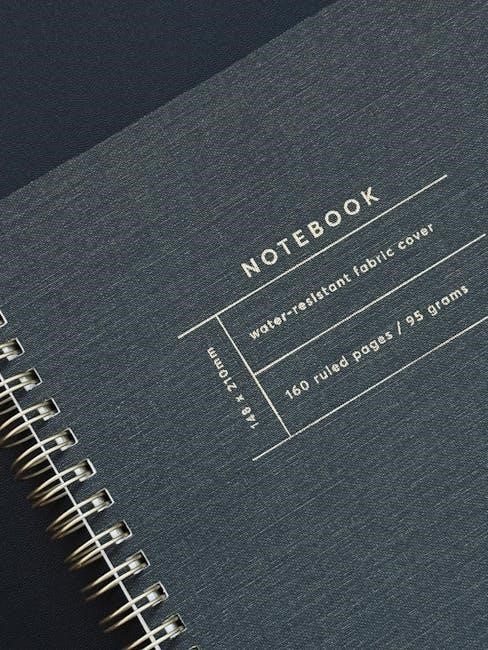Discover the perfect journal size with our comprehensive guide, exploring various dimensions and uses to help you make an informed choice for your writing, art, or travel needs.
Importance of Choosing the Right Journal Size
Choosing the right journal size is essential for ensuring comfort, usability, and productivity. A journal that is too small may limit writing space, while one that is too large can be cumbersome to carry. The correct size ensures your journal is portable yet provides enough space for your needs, whether it’s for daily notes, creative art, or travel documentation. Selecting a size that aligns with your lifestyle and preferences enhances your overall journaling experience, making it more enjoyable and practical. This guide helps you understand the importance of size selection to maximize functionality and personal satisfaction.
Overview of Common Journal Sizes
Journals come in a variety of sizes to suit different needs and preferences. Common sizes include A4, A5, A6, B5, and B6, each offering distinct dimensions and benefits. Pocket-sized journals, like 3.5 x 5.5 inches, are ideal for portability, while larger sizes such as A4 provide ample space for writing or art. Specialty sizes like Passport (3.54 x 4.92 inches) and Card Book (2.16 x 3.54 inches) cater to specific uses, such as travel or quick note-taking. Understanding these sizes helps users select the perfect fit for their lifestyle, ensuring both practicality and comfort. This guide explores these options in detail to aid in making informed decisions.

Understanding Standard Journal Sizes
Standard journal sizes are designed to balance portability and writing space, catering to various needs like writing, art, and travel. They offer versatility for everyday use.
A Series Journal Sizes
The A series offers a range of sizes, starting with A0 as the base size (1189mm x 841mm). Each subsequent size is half the area of the previous one. A6 (105mm x 148mm) is compact and portable, ideal for on-the-go use. A5 (145mm x 210mm) is a popular choice for daily journaling and planning. A4 (210mm x 297mm) is larger, suitable for detailed writing or professional use. A7 (74mm x 105mm) is the smallest, perfect for quick notes. These sizes provide versatility, catering to different needs from personal reflection to creative projects, ensuring there’s an A series journal for every purpose.
B Series Journal Sizes
The B series offers distinct dimensions, with B5 (176mm x 250mm) being a favorite for everyday use, balancing portability and writing space. B6 (125mm x 176mm) is slightly smaller, ideal for personal reflection and sketching. B7 (88mm x 125mm) is compact, perfect for quick notes. These sizes are popular for bullet journaling and art, providing ample space for creativity. The B series is known for its practicality, offering a range of options to suit various needs, from personal journals to professional use, ensuring there’s a B series journal that fits your lifestyle and preferences.
Other Common Journal Sizes
Beyond the A and B series, other common journal sizes include A7 (74mm x 105mm), which is ultra-compact for minimalists, and A3 (297mm x 420mm), ideal for art or detailed planning. The Letter size (8.5 x 11 inches) is popular in North America for professional and creative use. These sizes cater to specific needs, offering versatility for users seeking unique dimensions; Whether for sketching, note-taking, or artistic expression, these sizes provide diverse options, ensuring there’s a perfect fit for every preference and purpose.

Most Common Journal Sizes
Popular journal sizes range from pocket-sized (3.5×5.5″) to A4 (8.27×11.69″), offering portability, ample writing space, and versatility for daily use, creativity, or professional tasks.
Pocket Size (3.5 x 5.5 inches)
The pocket size journal, measuring 3.5 x 5.5 inches, is a popular choice for its portability and convenience. It easily fits into pockets, purses, or small bags, making it ideal for daily use. This size is perfect for jotting down quick notes, to-do lists, or even casual doodles. Its compact dimensions allow for effortless carrying, while still providing enough space for writing or sketching. Many users appreciate its balance between portability and functionality, making it a favorite for on-the-go journaling. Whether for personal reflection, bullet journaling, or creative expression, the pocket size offers a practical and versatile option for everyday needs.
A6 Size (4.13 x 5.83 inches)
The A6 size journal, measuring 4.13 x 5.83 inches, is a versatile and popular choice for journaling on the go. Its slightly larger dimensions compared to pocket-sized journals make it easier to write and sketch without sacrificing portability. This size is ideal for those who prefer a compact yet spacious format, fitting neatly into small bags or backpacks. A6 journals are often used for bullet journaling, travel notes, or creative projects, offering a practical balance between portability and writing space. Their moderate size makes them suitable for both everyday use and artistic expression, catering to a wide range of needs and preferences.
A5 Size (5.83 x 8.27 inches)
The A5 size journal, measuring 5.83 x 8.27 inches, is a highly popular and versatile option for journaling, writing, and artistic projects. Its spacious layout makes it ideal for detailed notes, bullet journaling, and creative expressions. Many users prefer the A5 size for its balance of portability and ample writing space, making it suitable for both everyday use and professional tasks. This size is widely available from most stationery brands and is often considered a favorite among planners and artists. Its dimensions provide a comfortable writing experience while remaining compact enough to carry in larger bags or backpacks, catering to a variety of needs and preferences.
B5 Size (6.93 x 9.84 inches)
The B5 size journal, measuring 6.93 x 9.84 inches, offers a generous writing surface while remaining portable. It strikes a balance between A5 and A4 sizes, providing ample space for detailed notes, sketches, and creative projects. This size is ideal for those who prefer more room to write or draw without the bulk of larger journals. B5 journals are popular among professionals and artists who need a versatile format for both productivity and creativity. The slightly larger dimensions make it easier to organize content, while its portability ensures it can be easily carried in backpacks or bags for everyday use.

A4 Size (8.27 x 11.69 inches)
The A4 size journal, measuring 8.27 x 11.69 inches, is one of the largest and most versatile options available. Commonly used in professional and academic settings, it offers an expansive writing surface, making it ideal for detailed notes, diagrams, and creative projects. A4 journals are perfect for those who require ample space to express their ideas without compromise. They are widely used in offices and homes, and their standard size ensures compatibility with most desk spaces. Despite their larger dimensions, A4 journals are still portable enough for everyday use, making them a practical choice for both productivity and creativity.

Specialized Journal Sizes
Explore specialized journal sizes designed for unique needs, such as Passport, Card Book, and B6 sizes, each offering distinct benefits for travel, quick notes, and balanced writing space.
Passport Size (3.54 x 4.92 inches)
The Passport Size journal, measuring 3.54 x 4.92 inches, is a compact and portable option ideal for travel enthusiasts. Its small dimensions make it easy to carry in a pocket or purse, allowing for quick note-taking and reflection on the go. Perfect for documenting travels, this size is lightweight yet durable, ensuring it can withstand being tucked into a bag or backpack. The Passport Size journal strikes a balance between portability and usability, offering enough space for writing without feeling bulky. It’s a favorite among adventurers and those who value convenience, making it a practical choice for capturing memories or inspiration while exploring new places.

Card Book Size (2.16 x 3.54 inches)
The Card Book Size journal, measuring 2.16 x 3.54 inches, is an ultra-compact option designed for quick notes and minimal writing. Its small dimensions make it ideal for carrying in wallets, purses, or even keychains, ensuring it’s always accessible. This size is perfect for jotting down short reminders, phone numbers, or inspiration that strikes on the go. Despite its tiny footprint, it offers enough space for essential information without feeling cramped. The Card Book Size is a favorite among those who prefer a no-frills, minimalist approach to journaling, providing convenience and portability for everyday use.
B6 Size (4.92 x 6.93 inches)
The B6 Size journal, measuring 4.92 x 6.93 inches, is a versatile and practical choice for everyday use. It offers ample writing space while remaining lightweight and easy to carry. This size is ideal for bullet journaling, sketching, and note-taking, as it provides a balance between portability and functionality. The B6 Size is slightly larger than A6 but smaller than A5, making it a great midpoint for those who need more space than a pocket journal but prefer a compact design. Its dimensions make it suitable for both personal and professional use, ensuring it fits neatly into bags or backpacks for on-the-go productivity.

Journals for Specific Needs
Explore journals designed for specific needs, such as travel, bullet journaling, and creative art. Each type offers unique features tailored to enhance your writing, planning, or artistic expression.
Travel Journals
Travel journals are designed to capture memories on-the-go, offering a compact and durable format for documenting adventures. Popular sizes like passport (3.54 x 4.92 inches) or pocket (3.5 x 5.5 inches) are ideal for portability. Many feature sturdy covers and elastic closures to withstand travel wear. Some include specialized pages for itineraries, maps, or ticket stubs. The A6 size (4.13 x 5.83 inches) also works well for travel, balancing portability with ample writing space. Whether backpacking or globe-trotting, a travel journal’s size should complement your journey, ensuring ease of use without compromising on style or functionality. Choose one that fits your travel lifestyle and documentation needs perfectly.
Bullet Journals
Bullet journals thrive on versatility, and choosing the right size is crucial for productivity. The A5 size (5.83 x 8.27 inches) is a favorite among bullet journalists, offering ample space for intricate layouts and collections. Smaller sizes like A6 (4.13 x 5.83 inches) or B6 (4.92 x 6.93 inches) are ideal for minimalists, providing a concise canvas for daily logs and tasks. Larger sizes, such as A4 or B5, cater to those who prefer expansive spreads for creativity. The size should align with your planning style, whether you prefer detailed designs or straightforward functionality. With the right dimensions, your bullet journal becomes a powerful tool for organization and self-expression.
Creative and Art Journals
Creative and art journals benefit from larger sizes to accommodate sketches, paintings, and mixed-media projects. The A4 size (8.27 x 11.69 inches) offers expansive space for bold artistic expressions, while B5 (6.93 x 9.84 inches) provides a balanced canvas for detailed work. Smaller sizes like A5 (5.83 x 8.27 inches) or A6 (4.13 x 5.83 inches) are also popular for portability and precise illustrations. The size should match the scale of your artwork and the mediums you use, ensuring ample room for creativity. Whether you prefer watercolor, ink, or collage, the right journal size will enhance your artistic process and inspire your next masterpiece.

Comparison Chart of Journal Sizes
Compare journal sizes easily with our chart, featuring dimensions and page counts. From A4 (8.27 x 11.69 inches) to A6 (4.13 x 5.83 inches), find the perfect fit for your needs.
Dimensions and Page Counts
Journals come in various sizes, each offering unique benefits. The A4 size (8.27 x 11.69 inches) is ideal for ample writing space, typically ranging from 80 to 100 pages. The A5 size (5.83 x 8.27 inches) is popular for its balance of portability and usability, often containing 100 to 200 pages. The B5 size (6.93 x 9.84 inches) provides slightly more space than A5, with page counts similar to A5. Smaller options like A6 (4.13 x 5.83 inches) and Passport (3.54 x 4.92 inches) are great for on-the-go use, usually featuring 80 to 120 pages. Each size caters to different needs, ensuring there’s a journal for every preference and purpose.
Portability vs. Writing Space
Choosing between portability and writing space depends on your primary needs. Smaller journals, like the A6 (4.13 x 5.83 inches) or Passport (3.54 x 4.92 inches), are lightweight and easy to carry, making them ideal for quick notes or travel. Larger sizes, such as A5 (5.83 x 8.27 inches) or B5 (6.93 x 9.84 inches), offer more writing space, suitable for detailed journaling or artistic expression. The A4 size (8.27 x 11.69 inches) provides extensive room for creativity but is less portable. Striking the right balance ensures your journal meets your lifestyle and usage preferences, whether you prioritize convenience or expansive writing areas.

Factors Influencing Journal Size Choice
Personal preference, intended use, and writing style are key factors in selecting a journal size, ensuring it aligns with your lifestyle and creative or practical requirements.

Personal Preference
Personal preference plays a significant role in choosing a journal size, as it directly impacts comfort and usability. Some individuals prefer smaller, portable options like pocket or A6 sizes for convenience, while others opt for larger formats like A4 or B5 for ample writing space. The size should align with how the journal will be used and carried, ensuring it feels natural to the user. Additionally, personal style and aesthetic preferences, such as cover designs or page layouts, can influence the decision. Ultimately, the right size is one that feels comfortable and inspiring, fostering a strong connection to the journal.
Intended Use
The intended use of a journal is a crucial factor in selecting the appropriate size. For instance, travel journals benefit from compact sizes like passport or pocket sizes, allowing easy portability. Conversely, art journals often require larger formats such as A4 to accommodate sketches and creative work. Bullet journals typically thrive in A5 or B5 sizes, offering ample space for detailed layouts. Daily to-do lists may find A6 sufficient, while extensive writing projects might prefer A4 for its expansive writing area. Matching the journal size to its intended use ensures practicality and enhances overall user satisfaction.
Writing Style
Your writing style significantly influences the ideal journal size. Those who prefer minimalistic and concise entries may find smaller sizes like A6 or pocket journals sufficient. Conversely, individuals with detailed or expressive writing styles often benefit from larger formats such as A5 or B5, which offer ample space for lengthy entries. Artists and sketchers may prefer even larger sizes like A4 or B4 for creative freedom. The size should complement your handwriting and the complexity of your content, ensuring a comfortable and enjoyable writing experience. Choosing a journal that aligns with your writing style enhances productivity and satisfaction, making it a personalized tool for self-expression.
Selecting the right journal size is a deeply personal decision, influenced by your lifestyle, writing habits, and creative needs. Whether you prioritize portability, ample writing space, or a balance between the two, understanding the options ensures you find the perfect fit. From compact pocket journals to spacious A4 sheets, each size offers unique benefits. By considering your intended use, writing style, and personal preferences, you can choose a journal that enhances your productivity, creativity, and overall journaling experience. This guide has equipped you with the insights to make an informed choice, helping you discover a journal that becomes your trusted companion for years to come.






























